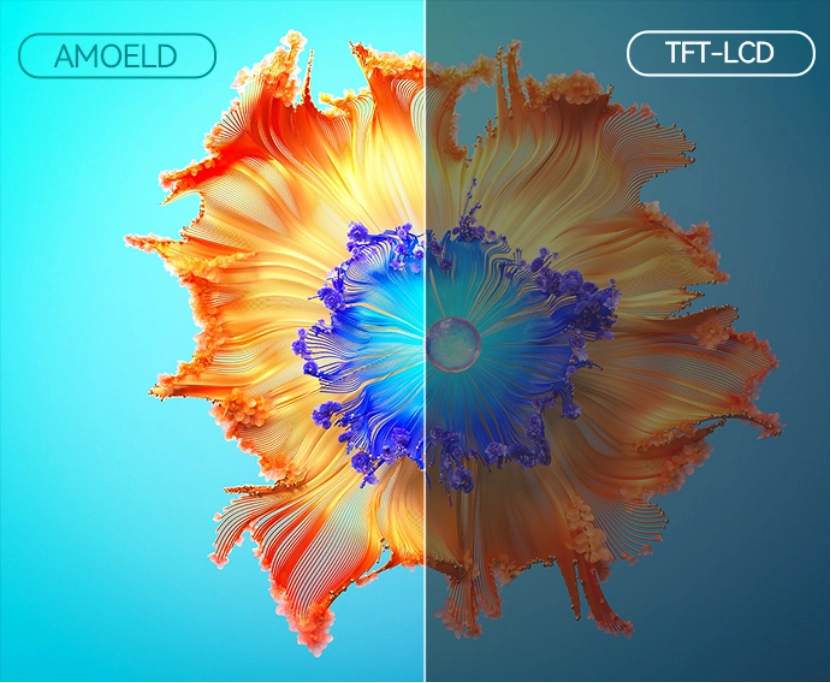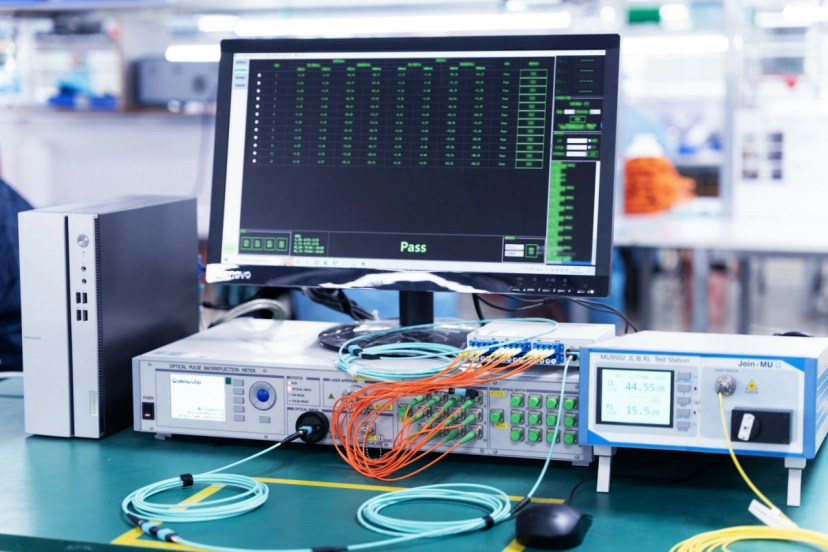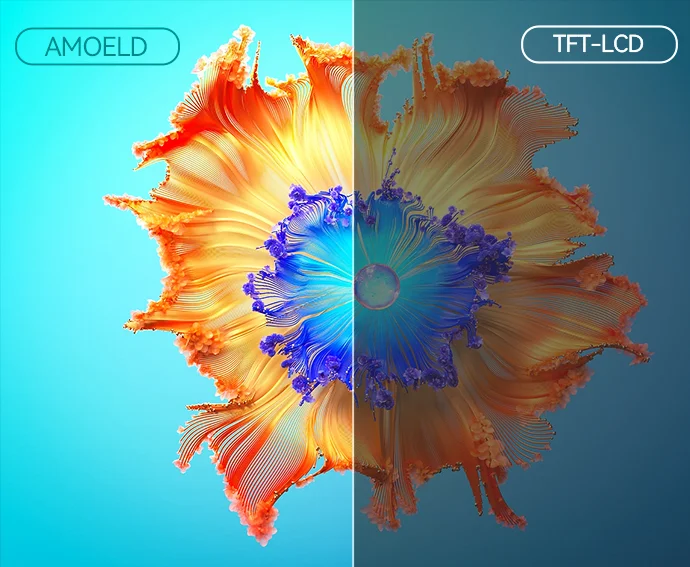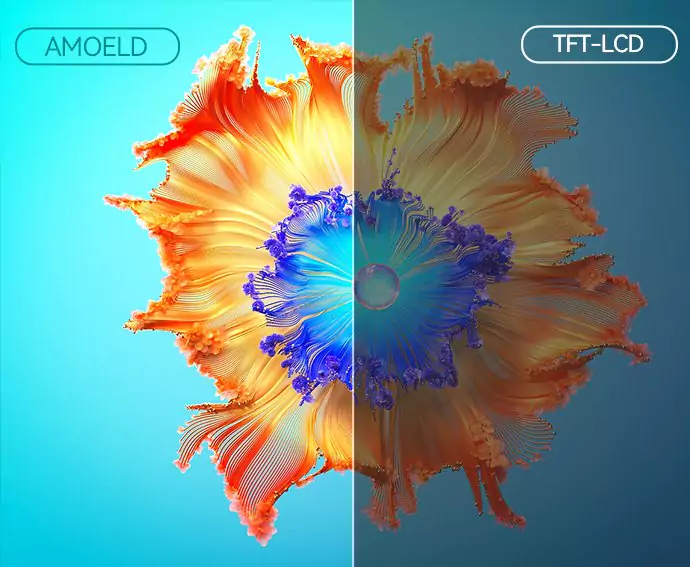Introduction to Display Technologies

What is TFT LCD?
TFT LCD stands for Thin-Film Transistor Liquid Crystal Display. It employs a light source to glow through liquid crystals. These crystals open and shut to create pictures. Since the light source stays active, the screen remains visible even when parts show black.
TFT LCD displays appear in many common gadgets. You see them in affordable phones, computer screens, hospital tools, factory machines, and vehicle panels. They provide consistent results and are simple to produce. This keeps prices low. When exploring tft lcd vs amoled, this option suits devices where dependability and cost matter more than appearance.
What is AMOLED?
AMOLED means Active Matrix Organic Light-Emitting Diode. Each dot on an AMOLED screen glows on its own using natural materials. No light source is needed. Dots can switch off entirely to display pure black. This creates a sharper contrast.
AMOLED is often found in premium phones, wrist devices, and bendable or curved screens. It gives gadgets a stylish and modern feel. When comparing amoled vs tft lcd for creativity and adaptability, AMOLED clearly stands out.
Key Differences Between TFT LCD and AMOLED Displays

Display Quality and Performance
One major difference between tft lcd and amoled is the clarity of images. AMOLED produces richer blacks. It can turn off single dots. This results in a very strong contrast ratio. Conversely, TFT LCD keeps its light source on. So, blacks look more like dim gray.
For colors, TFT LCD often shows truer and more lifelike shades. This helps with tasks needing exact colors, like editing photos. AMOLED tends to display brighter and bolder colors. Many users love this for watching clips or playing games.
Another factor in the tft lcd display vs amoled display discussion is speed. AMOLED responds quickly to fast-moving images. This makes it great for gaming or viewing sports and action films.
Energy Efficiency
Power use is a key point when asking what is the difference between tft lcd and amoled. AMOLED consumes less energy for dark colors. Black dots switch off completely. This saves battery, especially in dark mode or with always-on screens.
TFT LCD uses the same power regardless of the image. Its light source stays on. This drains the battery faster. For portable gadgets, AMOLED is often better for saving energy.
Durability and Lifespan
When it comes to screen longevity, TFT LCD usually lasts longer. It avoids issues like burn-in. Burn-in occurs on AMOLED when a fixed image stays too long. This leaves a faint shadow behind.
Yet, newer AMOLED technology reduces this problem. Still, for screens showing static images, like in information booths or control boards, TFT LCD is safer. The difference between amoled and tft lcd here may also affect repair and replacement costs.
Design Flexibility
AMOLED offers greater design freedom. The screen is slimmer and can curve. This is why it’s used in foldable phones and wrist gadgets. If you’re creating something cutting-edge, AMOLED provides more choices.
TFT LCD is bulkier and cannot bend. However, it performs better in bright sunlight. This makes it reliable for outdoor gadgets. In the tft lcd vs amoled debate, the right pick depends on your product’s design goals.
Pros and Cons of TFT LCD vs AMOLED
Advantages of TFT LCD
TFT LCDs cost less to make. They suit budget-friendly gadgets. They also shine brightly outdoors. Their high brightness helps visibility. Plus, they display colors in a balanced way. This matters for medical or technical screens.
Disadvantages of TFT LCD
TFT LCD has flaws. Its design is chunkier. This limits how slim or stylish a gadget can look. It also consumes more power due to the constant light source. Compared to AMOLED, it lacks deep blacks and vivid colors.
Advantages of AMOLED
AMOLED is ideal for sleek, premium designs. It delivers stunning contrast with pure blacks. It often saves battery power. Being thinner, it allows lighter and more fashionable gadgets.
Disadvantages of AMOLED
AMOLED screens cost more. They may suffer burn-in over time. Some users find the colors too intense or unnatural. So, the difference between tft lcd and amoled can affect performance and price, depending on the use.
Which Display is Better for Your Needs?

Ideal Use Cases for TFT LCD
TFT LCD is perfect for gadgets needing outdoor performance. It suits devices that don’t need flashy colors or must stay cheap. Examples include factory machines, affordable tablets, or hospital screens.
When to Choose AMOLED
Pick AMOLED for top-tier visuals and modern looks. It’s best for phones, media players, and bendable screens. For users who watch lots of videos, AMOLED offers a thrilling experience.
Cost vs Performance Trade-offs
When choosing between tft lcd display vs amoled display, consider your priorities. Do you value design and picture quality? Or do cost and durability matter more? For dazzling visuals to impress users, choose AMOLED. For something steady and budget-friendly, TFT LCD is the answer.
Kadi Display’s Customization Services for TFT LCD and AMOLED
Tailored Solutions for Unique Projects
At Kadi Display, we provide custom options for both TFT LCD and AMOLED displays. Need a tough screen for factory tools? Or a slim, colorful panel for a wearable device? We can create it.
We also offer screens compatible with Raspberry Pi. We provide embedded touch screens and special bonding techniques. These improve clarity and strength. Whatever your industry, we’ll help find the best solution.

Why Partner with Kadi Display?
With over 20 years of expertise and a 5,000㎡ production area, Kadi Display delivers top-notch screens quickly. We offer expert support for HDMI or DSI connections, touch features, and all types of screen customizations.
Still wondering what is the difference between tft lcd and amoled? Unsure which suits your project? Our team is ready to assist. We focus on turning your ideas into practical display solutions.
FAQs About TFT LCD vs AMOLED Displays
Which lasts longer: TFT LCD or AMOLED?
TFT LCD generally lasts longer. AMOLED may wear out faster, especially with constant static images.
Does AMOLED consume less battery than TFT LCD?
Yes. AMOLED uses less power for black or dark content. This extends battery life.
Can AMOLED screens get burn-in?
Yes, but newer AMOLED screens have features to reduce this risk. It’s less common now but still worth considering.
Is TFT LCD better for outdoor use?
Yes. TFT LCD performs better in direct sunlight. It’s easier to read outdoors.
Which is cheaper: TFT LCD or AMOLED?
TFT LCD costs less. It’s often used in gadgets where price is a key factor.
Conclusion
Making the Right Choice
The difference between AMOLED and TFT LCD goes beyond appearance. It involves how you’ll use the screen. Consider your budget and priorities. Do you need design, energy savings, or durability? AMOLED offers sharp visuals. TFT LCD provides reliability. There’s a great option for everyone.
Need Expert Guidance? Contact Kadi Display!
Choosing between TFT LCD and AMOLED can feel tricky. At Kadi Display, we’re here to help. Whether you’re building a sturdy factory monitor or a futuristic foldable gadget, our team will craft a display that matches your vision. Email us at Sales@sz-kadi.com or call 0086-13662585086. Let’s bring your display ideas to life—no detail overlooked!
Latest Blog & News
- Why a Touch Screen Car Stereo Is a Smart Upgrade for Any Vehicle
- Why Stretched Bar LCD Displays Are Ideal for Car Dashboards
- Industrial Displays in Vending Machines
- How to pick the best display for an EV charger?
- Advanced Industrial Display Interface Technologies: HDMI, DP, USB-C – Which is Best for Industrial










